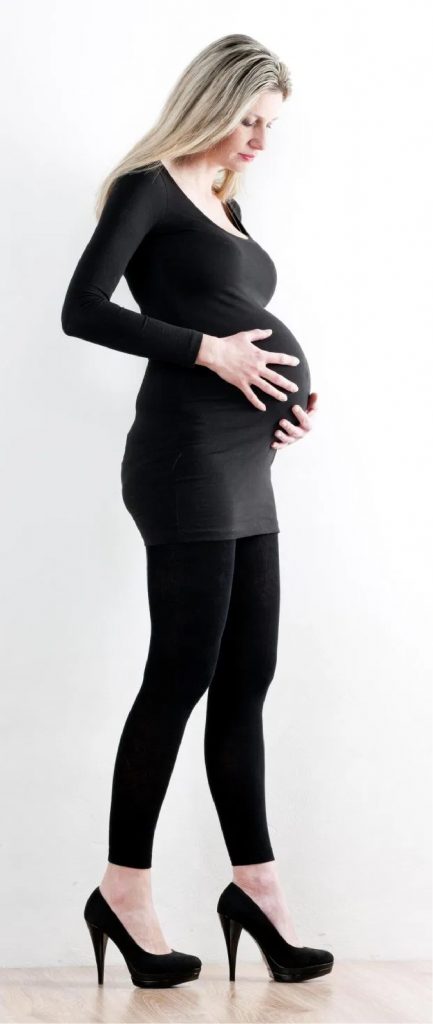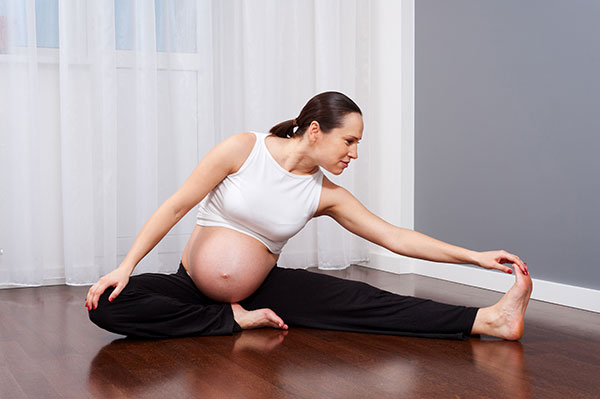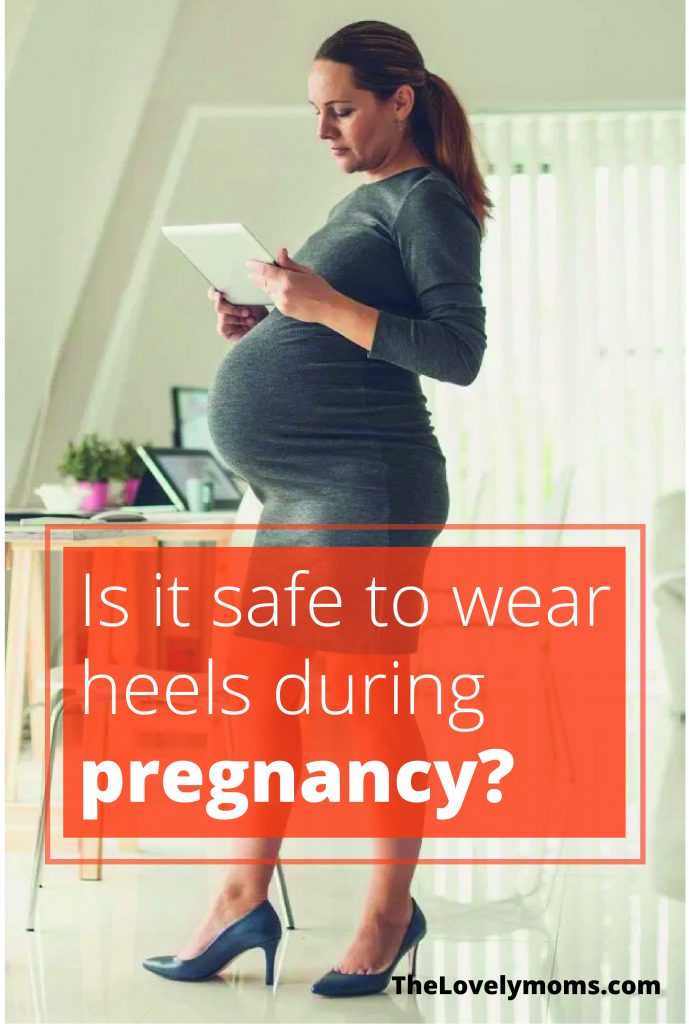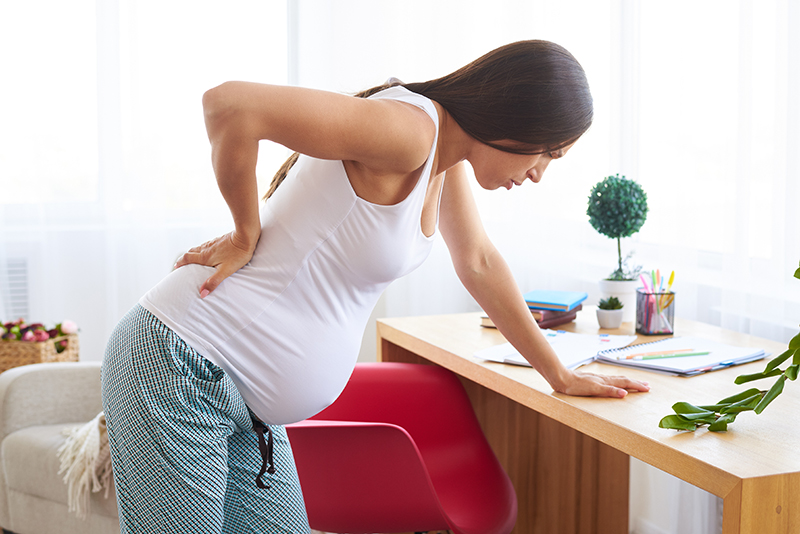Check out what experts think about the accessory and what are the most recommended footwear for future moms

Who said fashion and pregnancy don’t match has never seen the pictures of model Ashley Graham! The American is always fueling her social networks with fabulous images of stylish clothes that respect her pregnancy curves. In some of them, the future mom appears parading on top of shoes with thin heels and arouses doubts – and judgments. But, after all, can or can’t you wear high heels in pregnancy? Understand what experts think about it.
Although the accessory is, for many, symbol of elegance, professionals agree that high heels can negatively affect the woman’s posture. When the mother’s belly grows and the weight goes forward, there is a process of displacement of the center of gravity – which is in the navel region – causing a possible imbalance, which can be aggravated by the use of high heels.
This deviation in the anatomical axis of the body can lead to alteration of the spine and lower limbs. If use is daily, the risk of the pregnant woman develops pathologies, especially in the region of the feet, heels, ankles, knees and back.
Our body works as if it was a two-movement pendulum, sometimes forward, with his right leg and left arm as a back, and prays back. As the jump changes the operating axis of gait, a complex locomotion mechanism used by the body to maintain displacement with lower caloric and effort expenditure, a process of compensatory rebalancing of the organism with greater effort and risk of injury is generated certain parts of the body.
While in normal shoes the front of the foot receives 40% of the body load and the posterior 60%, in high heels the front can receive up to 100% of the force. Over time, overuse causes pain in the foot plant, because of pressure in metatarsals; tendinitis and bursitis; fracture of metatarsals due to fatigue; nail problems, because of the pressure.
The inclination of high heels is the real villain in this case. When wearing the high heels, you stay at the tip of your foot and the calf muscles contract. So it’s like you’re doing an isometric exercise. This generates a muscle shortening, and can cause chronic pain in the long run.
Furthermore, another common complaint among pregnant women is low back pain. The weight of the belly projected forward accentuates the lumbar curvature, and can turn into a hyperlordosis – a condition in which there is an excessive increase in the curvature of the body, in the front direction of the abdomen.
Increased curvature of the lumbar spine is one of the characteristic changes in pregnancy. With the growth of the uterus there is a displacement of the center of gravity of the body forward, intending the spine. With the use of high heels, the pregnant woman can intensify this change as a way to improve balance, which can increase the chances of pain in the lumbar spine (low back pain) and in the lower limbs.
And what’s the most comfortable type of footwear?
The proper shoe in pregnancy is that comfortable for you. Now, if you really want to wear the high heel, it’s ideal that it’s up to 3 centimeters long. Although many pregnant women bet on sneakers, this is not considered the best option. The sole is usually thin, without cushioning, and this sucks for the spine – and for the knees, hips, ankles and joints.
In addition to so many body changes, it is normal for pregnant women to feel more swollen in some members of the body. So the tip is to avoid the tight shoes. The hormonal issue may favor water retention, especially in the feet. Therefore, the shoes cannot be tightened. Invest in shoes with wider bases, because your feet swell sideways.

The best solution is to invest in good posture and body awareness. The woman can prepare during pregnancy, doing pilates, stretching and bodybuilding exercise, for example – always guided by her doctor. Thus, she gains muscle mass to support the spine and additional weight.
And if the pregnant woman spent the day on top of a high heel, some care is important. It is recommended for women to alter the height of the jump, always giving preference to platform style, and at the end of the day it is interesting to stretch the calf well and massage their feet with a relaxing cream specific to the area in order to avoid pain and problems in the long way Term.
Can pregnant women wear heels on special occasions?
The ideal is to avoid high heels during pregnancy or at least leave to use only on special occasions. The problem is that the high heels modifies posture and alters the center of gravity, putting more pressure on the lumbar region of the spine, already quite vulnerable in pregnancy.
The ligaments that guarantee the stability of the spine become looser during pregnancy, which leaves them more subject to injuries and overloads. That’s why pregnant women are more at risk of twisting their feet, and high heels also contribute to risk. Another problem with high heels, according to some doctors, is that by pressing the lumbar region more, they can contribute to spinal pain, which can be very intense.
In addition, weight gain, changing body shape and changing the center of gravity make pregnant women walk in a different way and with less stability. Thus, the use of high heels can cause imbalance. And a fall during pregnancy can hurt you and even your baby. Platform jump shoes are more comfortable to walk, but have the same risk of falling: they make it much easier to turn your foot, especially when the floor is jagged or slippery.
Also pay attention to see if the sole of the shoe is not very smooth, which can make the shoe slippery.
There are women who feel uncomfortable wearing shoes completely without high heels. This type of shoe can also favor pressure on the heel and spine. If that’s your case, look for a medium heel shoe and wide base that gives plenty of support.
How to wear high heels in pregnancy
Learn what to do to maintain elegance and minimize swelling of the feet during the nine months

Experts who are in favor of the low shoes say that the imbalance increases with belly growth, especially from the fifth month of gestation.
This imbalance occurs because some hormones whose rates increase during pregnancy, such as relaxin, estrogen and progesterone, promote the laxity of ligaments. Since the ligaments serve to maintain the joints that sustain our body, if they loosen, the joints become more fragile and, consequently, susceptible to twists. The high heels causes changes in the center of gravity of the body, contributing to the imbalance and bringing risks to pregnant women, such as twists and falls.
In addition, constant use of high heels in pregnancy can cause lumbar hyperlordosis. This happens when the curvature of the spine is accentuated, providing pain, discomfort and poor posture.
If you do not give up the jump, the ideal is to choose a model up to 3 cm high. The shoes that have the back closed are better because they give more stability.
TheLovelyMoms
You can, for example, take a pair of sneakers or low shoes in the bag and shut them up after work (or at the end of the party). Or move on to models without high heels from 25 weeks of gestation. Or give up the high heels to do the day-to-day tasks and book it for special occasions.
How to soften swelling
Swelling in the legs and feet is common. This is because, during pregnancy, there is an increase in the amount of blood and fluids in the body in general. The circulatory system changes and, when it does not account, generates the problem. The growth of the uterus, which accompanies the development of the baby and compresses the vessels of the pelvic region, also impairs circulation.
Some practices that promote calf contraction help reduce swelling: Hiking and going down and climbing ramps at your toes are exercises that help. Decreasing salt and gaining only the ideal weight for pregnancy are also important, as well as wearing compressive panting and making lymphatic drainage. These last options, however, need to be analyzed by the doctor, as some patients have contraindications, such as renal failure, high blood pressure and thrombosis.
Stay tuned to habits
During pregnancy, some changes in habits are necessary to preserve the health of women and babies. They are care ranging from food, which should be healthier, to aesthetic issues such as hair dyes, skin treatments or the most appropriate clothes.
This type of footwear can become harmful from the moment changes begin in the body, especially those that cause changes in the balance shaft and overload on the back. Due to the risk of falls and worsening pain, there is a recommendation to avoid high heels from the start.
Low shoes and slippers are good alternatives as they ensure greater balance. A tip for those who are very used to high heels is to make a gradual reduction in height during the first months of pregnancy.
If the occasion is special and requires a high heel, the recommendation is to wear with thicker heels to give more stability.
Doctors say that in these cases, care needs to be taken and avoid many displacements, as there is really a higher risk of falling and worsening pain in the lumbar region.

If you spend too much time walking around on high heels, the tip is to make rest with the lower limbs elevated.
Some shoes can also contribute to swelling of the feet in pregnancy, as well as staying for a long time standing and without rest. So it is important to rest a few minutes throughout the day with high legs.
Pregnancy is a unique and special moment for women and among the doubts that arise throughout this period, one of them is whether the use of high heels during pregnancy or not impairs posture. The use of this type of footwear is not prohibited, however, some care is required.
With the advance of pregnancy and the increase in body overload, it is important to balance the use of high, medium, low and platform heels.
Frequent use of high heels leads to shortening of the posterior muscles of the leg. In addition, another feature of this period is swelling (edema) of the legs and ankles.
Still, the use of high heels in the last quarter of pregnancy for a social occasion, such as a party, can be considered as long as the woman feels safe, with an appropriate posture that generates comfort and well-being. Always take into account what type of environment the high heel will be used and if it does not bring risks.
Therefore, the recommendation for jump height is one that best accommodates body structure as a whole and which, mainly, makes the proper distribution of support points during walking.
One tip is that after prolonged use of the jump, the pregnant woman performs stretching exercises.
1 Disclaimer: Any answers to questions posed and any recommendations or information provided therein should not be used as a substitute for medical or relevant other advice by a health care provider or parenting professional.
2 Disclaimer: This post may have affiliate links.
